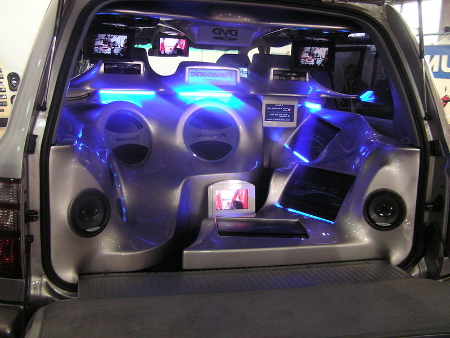The basic components of a high-quality car stereo system are an AM/FM tuner, a CD player, an amplifier (optional but recommended) and great speakers.

Rule: No auto audio can equal the performance of fine home equipment. The car compartment is small, besieged with engine and traffic noises, and surrounded with competing electrical signals. And all of this in a moving environment. A welter of technical and personal choices dictate the final package.
General guidelines: Shop around. Car audio components are often discounted. Check mail-order houses and the Internet for the best buys.
Essential: Deal with reputable businesses and buy name brands. Make sure you can exchange or return components in case they prove incompatible or do not fit into the car. Remember each unit must be installed and may require custom mounting accessories. Keep personal tastes in mind. Rock and country music fans usually prefer stronger bass ranges. Classical music requires good mid and treble.
How to allocate your spending: 40% to 50% for tuner/tape player, 25% to 30% for amplifier, 25% to 30% for speakers (unlike home gear, for which half the recommended expenditure may go for speakers alone).

General recommendations: Components are a better deal than manufacturer-installed original sound equipment. Good manufacturer-installed gear can cost $1,000, a price that will usually bring you far better sound if spent on components. Try to find a dealer that has set up a sound room to hear and compare different systems.
New-car buyer strategy: Buyers planning to purchase components should insist on a delete-option clause, eliminating the installed radio cost.
In-dash versus under-dash components. Under-dash components are easily installed.
Overriding disadvantage: A thief can slip out the under-dash gear as easily as an ashtray. Choose in-dash tuner/CD players unless you want to stow the components in the trunk each time you leave the car. (If you still prefer an under-dash system, Sony components are top-notch ones.)
Amplifiers: Most auto-sound packages benefit from amplifiers that strengthen bass and high-treble tones.
Problems: Amplifiers are bulky and often must be installed under a seat or in the trunk. Unless your tuner has a bypass circuit permitting you to plug into the preamplifier, your costly amplifier will only boost the distorted output of the built-in amplifier.
Smart buying: Look for amplifiers measuring power in watts (w) per channel in terms of distortion (THD). Goal: About five watts per channel at 1 % distortion or less. To get this, the amplifier may require 50 watts per channel because few operate at better than 10% efficiency in a car.
Bi-amplifiers: They offer separate power boosts for bass and treble ranges. Bi-amplification may be called for when separate bass and treble speakers are installed.
Speakers: Speakers must be compatible with amplifiers. Their power capacity should be slightly higher than amplifier. Example: Get 60w speakers for a 50w /ch amplifier. One way to be sure of speaker/amplifier compatibility is to purchase them as a package.
Stereo sound requires at least two speakers. Many enthusiasts choose four. Non-directional bass speakers are best placed in the factory cutouts in the rear window shelf. Next best placement: In rear doors. Treble speakers can be mounted in front door panels or under dash.
Installation: Unless you are highly skilled electronics hobbyist, have the auto-sound system professionally installed. Allow $150 to $200 for installation, and get a satisfaction guaranteed agreement.
Tim is a web developer, artist, musician, insurance consultant and loves to learn and try new things. He loves spending time with his wife and family. |
Visit Car Review for Daily Updated Hairstyles Collection






0 comments:
Post a Comment